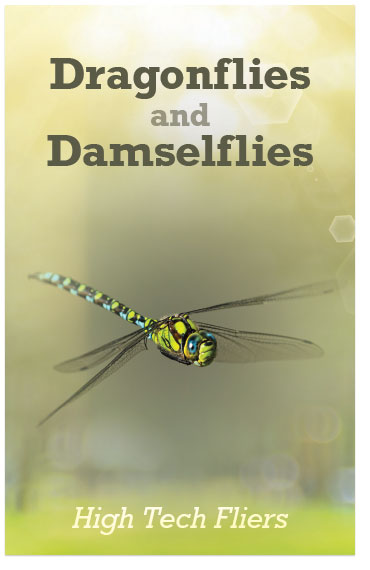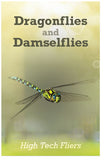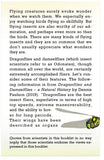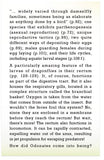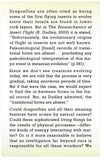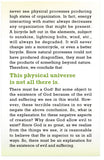Dragonflies and Damselflies
Special-Order Folded Tract
 NOTE: This item is custom-printed to order (click for more details).
NOTE: This item is custom-printed to order (click for more details).
This tract is from our print-on-demand library, and is not kept in stock. Select the options below, and we will custom-print a batch just for you. Because this item is custom-printed, you can add your custom imprint to the back page at no extra cost.
- Estimated shipping date: Friday, December 5 (Click for more details)
- SKU:
- Discounts: Discount coupons do not apply to this item
- Format: Folded Tract
- Size: 3.5 inches x 5.5 inches
- Pages: 8
- Imprinting: Available with 5 lines of custom text
- Returns: Because this item is custom-printed to order, it cannot be returned.
Show all item details
The full text of this tract is shown below. (Do you want to print this tract in a different version than the one listed? Contact us and let us know what you're looking for—we may be able to create the alternate version for you at no charge.)
Flying creatures surely evoke wonder when we watch them. We especially enjoy watching birds flying so skillfully. But flying insects are also worthy of our admiration, and perhaps even more so than the birds. There are many kinds of flying insects and they are so common that we don’t usually appreciate what wonders they are.
Dragonflies and damselflies (which insect scientists refer to as Odonates), though common all over the world, are certainly extremely accomplished fliers. Let’s consider some of their features. The following information is from Dragonflies and Damselflies – a Natural History by Dennis Paulson (2019). “Dragonflies are the best insect fliers, superlative in terms of high top speeds, extreme maneuverability, and the ability to hover for long periods. Their wings have been described as organs that have optimized their mechanical structure and their biological function” (p.50). “Odonate wings are miracles of construction” (p.50). He went on to add, “Odonates can beat each of their four wings independently, which provides a maximum of aerial agility” (p.52). How the miniscule dragonfly brain can coordinate those four wings for precise, split-second maneuvers is an additional wonder.
Paulson also details the wonders of dragonfly vision, which is essential for highly controlled flight. “In larger species, each of the compound eyes contains up to 30,000 simple eyes, more than in any other insect group” (p.54). “Their large eyes allow them just about total vision in all directions” (p.54).
Paulson’s book includes descriptions of numerous highly complex behaviors exhibited by these insects. This includes long migrations (pp.76, 140, 160); males of some species changing color (p.62); courtship:
“… widely varied through damselfly families, sometimes being as elaborate as anything done by a bird” (p.92); one species that exhibits parthenogenesis (asexual reproduction) (p.72); unique reproductive tactics (p.96); two quite different ways of depositing their eggs (p.89); males guarding females during egg laying (p.101); and their life cycles, including aquatic larval stages (p.108 f.).
A particularly amazing feature of the larvae of dragonflies is their rectum (pp. 128-129). It, of course, functions as part of the digestive tract. But it also houses the respiratory gills, located in a complex structure called the branchial basket! Oxygen is taken from the water that comes from outside of the insect. But wouldn’t the feces foul this system? No, since they are enclosed in a membrane before they reach the rectum! But wait, there’s more! The rectum also functions in locomotion. It can be rapidly contracted, expelling water out of the anus, resulting in jet propulsion for escaping predators!
How did Odonates come into being? Dragonflies are often cited as being some of the first flying insects to evolve since their fossils are found in lower rock layers. But in The Biomechanics of Insect Flight (R. Dudley, 2000) it is stated, “Unfortunately, the evolutionary origins of flight in insects are not well known. Paleontological [fossil] records of transitional forms are absent … precluding any paleobiological interpretation of this major event in metazoan evolution” (p.261).
Since we don’t see creatures evolving today, we are told that the process is very gradual, taking enormous periods of time. But if that were the case, we would expect to find the in-between forms in the fossil record. But, as Dudley admitted, the “transitional forms are absent.”
Could dragonflies and all their amazing features have arisen by natural causes? Could these sophisticated living things be the results of physical processes—different kinds of energy interacting with matter? Or is it more reasonable to believe that an intelligence far beyond ours is responsible for all these wonders? We never see physical processes producing high states of organization. In fact, energy interacting with matter always decreases any organization that might be present. A bicycle left out in the elements, subject to sunshine, lightning bolts, wind, etc., will always be degraded. It will never change into a motorcycle, or even a better bicycle. Since natural processes could not have produced dragonflies, they must be the products of something beyond nature. Therefore, we conclude that:
This physical universe is not all there is.
There must be a God! But some object to the existence of God because of the evil and suffering we see in this world. However, these terrible realities in no way negate the above conclusion. So, what is the explanation for these negative aspects of creation? Why does God allow evil to exist? Since God is so great, as we realize from the things we see, it is reasonable to believe that He is superior to us in all ways. So, there must be an explanation for the existence of evil and suffering.
If we have a sense of justice, then God is even more just. And, if we can love our children, then God must love us even more. So, since we do not always see justice and love prevail in this world, we conclude that this life is not all there is. There will come a day when God will judge us to see who is fit to inhabit a new and better world, where justice and love will prevail.
The question now arises—what must we do in order to enter that better world? In the Bible, God tells us that we must repent because He will judge the world in righteousness (Acts 17:30,31). To repent means to turn to God and to seek to do His will in all things. For those who repent, God has graciously provided a way that we may receive forgiveness for all the wrong doings of our past. This way is Jesus Christ. He died for all our wrong doings and rose again from the dead, conquering death itself. Through repentance and faith in Jesus Christ’s sacrifice for our sins, we can be forgiven and therefore be assured that we will be in that better world to come in which there will be no death nor any evil or suffering.
If it is your desire to repent, tell God that is your intention and ask Him to help you to live a life in accordance with His will. Then read the Bible, especially starting with the New Testament, to learn how God wants us to live. If you are really serious about doing God’s will, however, you will find that this is not always easy. Others will seek to influence you away from that. And even our own selfish inclinations are contrary to doing God’s will. To get extra help, get involved with others who are also seeking to do God’s will. There are millions of such people all over the world. You can find them in Christian churches where the Bible is believed. Pray and ask God to direct you into such a church. You might want to use the internet to look up Bible believing churches in your area.
* Quotes from scientists in this booklet in no way imply that those scientists endorse the views expressed in this booklet.

